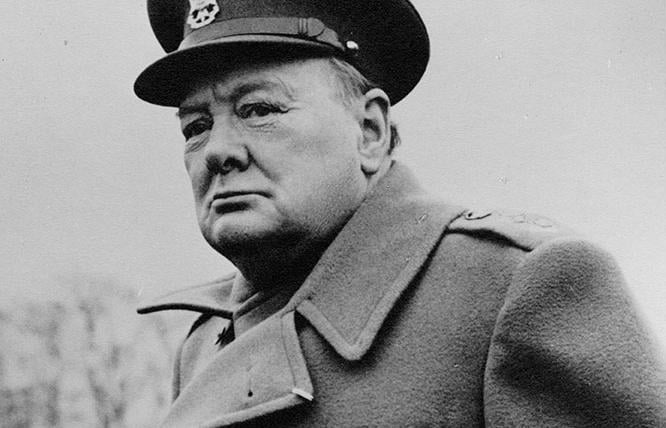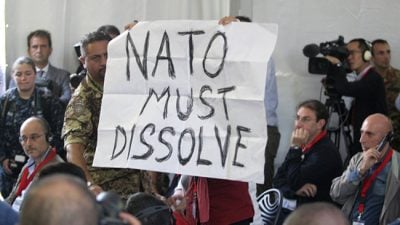The Following text is Section 1 of
The 70 Years of NATO: From War to War,
by the Italian Committee No War No NATO
*
First published by Global Research in April 2019
Documentation presented at the International Conference on the 70th Anniversary of NATO, Florence, April 7, 2019
In the course of the next two weeks, Global Research will publish the 16 sections of this important document, which will also be available as an E-book.
*
Contents
1. NATO is born from the Bomb
2. In the post-Cold War, NATO is renewed
3. NATO demolishes the Yugoslav state
4. NATO expands eastward to Russia
5. US and NATO attack Afghanistan and Iraq
6. NATO demolishes the Libyan state
7. The US/NATO war to demolish Syria
8. Israel and the Emirates in NATO
9. The US/NATO orchestration of the coup in Ukraine
10. US/NATO escalation in Europe
11. Italy, the aircraft carrier on the war front
12. US and NATO reject the UN treaty and deploy new nuclear weapons in Europe
13. US and NATO sink the INF Treaty
14. The Western American Empire plays the war card
15. The US/NATO planetary war system
16. Exiting the war system of NATO
***
1. The events that gave birth to NATO begin when the United States dropped atomic bombs on Hiroshima and Nagasaki in August 1945, not to defeat Japan, now at the end, but to come out of the Second World War with the greatest possible advantage, especially over the Soviet Union. This was made possible by the fact that, at that time, the United States was the only country that possessed nuclear weapons.
2. Just a month after the bombing of Hiroshima and Nagasaki, in September 1945, the Pentagon calculated that it would take about 200 nuclear bombs to defeat an enemy the size of the USSR.
 On March 5, 1946, Winston Churchill’s speech about the “Iron Curtain” officially started the Cold War. Soon after, in July 1946, the USA carried out the first nuclear tests in the atoll of Bikini (Marshall Islands, Pacific Ocean) to confirm nuclear bombs’ effectiveness on the disarmament of a group of ships and thousands of guinea pigs. More than 40,000 US military and civilians participated in the operation that included over 250 ships, 150 aircraft and 25,000 radiation detectors.
On March 5, 1946, Winston Churchill’s speech about the “Iron Curtain” officially started the Cold War. Soon after, in July 1946, the USA carried out the first nuclear tests in the atoll of Bikini (Marshall Islands, Pacific Ocean) to confirm nuclear bombs’ effectiveness on the disarmament of a group of ships and thousands of guinea pigs. More than 40,000 US military and civilians participated in the operation that included over 250 ships, 150 aircraft and 25,000 radiation detectors.
3. In 1949, the US nuclear arsenal rose to about 170 nuclear bombs. At this point the United States surely had enough bombs to attack the Soviet Union within a short period of time. That same year, however, the United States’ plan to preserve its monopoly on nuclear weapons failed.
On August 29, 1949, the Soviet Union carried out its first experimental nuclear explosion. A few months earlier, on April 4, 1949, when Washington knew that the Soviet Union was about to have the nuclear bombs and was about to start the nuclear arms race, the United States created NATO. During the Cold War, the Alliance under US command included 16 countries: United States, Canada, Belgium, Denmark, France, German Federal Republic, Great Britain, Greece, Iceland, Italy, Luxembourg, Norway, Netherlands, Portugal, Spain, Turkey. Through this alliance, the United States maintained its dominance over European allies, using Europe as the front line against the Soviet Union.
4. Six years after the formation of NATO, on May 14, 1955, the Warsaw Pact was born, which included the Soviet Union, Bulgaria, Czechoslovakia, Poland, the German Democratic Republic, Romania, Hungary and Albania. (The Warsaw Pact continued from 1955 to 1968.)
5. As the nuclear confrontation between the US and the USSR began, Britain and France, both members of NATO, moved to also equip themselves with nuclear weapons. The first to succeed was Great Britain, which in 1952 carried out an experimental explosion in Australia. NATO’s advantage increased further when, on November 1st of the same year, the US detonated its first H (hydrogen) bomb. In February 1960, NATO countries with nuclear weapons rose to three when France detonated its first nuclear bomb in the Sahara.
6. While the nuclear arms race was in full swing, the missile crisis in Cuba exploded in October 1962. After the armed invasion of the island by CIA-backed exiles in April 1961 failed, the USSR decided to provide Cuba with medium and intermediate range ballistic missiles. The United States carried out the naval blockade of the island and put their nuclear forces on alert. Over 130 intercontinental ballistic missiles were ready for launch, and 54 bombers with onboard nuclear weapons were added to the 12 bombers that the Strategic Air Command always kept in flight 24 hours a day, ready for nuclear attack. At the time, the United States had more than 25,500 nuclear weapons, to which about 210 were added, while the USSR had about 3,350. The crisis, which took the world to the threshold of nuclear war, was defused by the Soviet decision not to install the missiles in exchange for a US commitment to lift the blockade and respect the independence of Cuba.
7. At the same time, China moves towards the acquisition of nuclear weapons and, in October 1964, explodes its first uranium bomb and, in less than three years, its first H-bomb.
8. Hand in hand with the growth of its arsenal, the Pentagon developed detailed nuclear war operational plans against the USSR and China. An 800-page dossier – made public in 2015 by the US National Archives – contains a list (until then classified) of thousands of targets in the USSR, Eastern Europe and China that the US was preparing to destroy with nuclear weapons during the Cold War. In 1959, the year to which the “target list” refers, the US had more than 12,000 nuclear warheads and the British had 80, while the USSR had about a thousand, and China had none up to that point. Due to having superior transportation (bombers and missiles), the Pentagon considered a nuclear attack to be feasible.
9. Paul Johnstone, a Pentagon nuclear war planner and analyst for two decades (1949~1969), has revealed that at the time of the Cold War, there was the conviction among US strategists that the United States would suffer serious damage and have millions of deaths, but it would continue to exist as an organized and viable nation, and it would prevail, while the Soviet Union would not be able to do so.
10. Between the late 60s and early 70s, the US had about 9,000 nuclear weapons deployed outside its territory: about 7,000 in European NATO countries and 2,000 in Asian countries (South Korea, Philippines, Japan). Besides these, they have 3,000 weapons aboard submarines and other naval units, which can be launched at any time from advanced positions against the Soviet Union and other countries. The USSR, which has no advanced bases outside its territory near the United States (to which it can approach, however, using nuclear submarines), tried to prove that, if attacked, it could launch a devastating retaliation. To confirm this fact, in a test conducted on October 20, 1961, the most powerful hydrogen bomb ever experienced, the 58-megaton “Zar”, equivalent to almost 4,500 Hiroshima bombs, was detonated. At the same time, the Soviet Union prepared a space weapon: a missile that, if put in orbit around the Earth, could strike the United States at any moment with a nuclear warhead.
11. At this point the United States, facing a difficult position, proposed to the Soviet Union a treaty on the peaceful use of space. Thus, in January 1967, the Treaty on outer space was signed, which forbids the placing of nuclear weapons in the Earth’s orbit, on the Moon or on other celestial bodies, or, in any case, to place them in extra-atmospheric space.
12. Immediately afterwards, in July 1968, the Nuclear Non-Proliferation Treaty (NPT) was signed. The United States, Great Britain and the Soviet Union promote it, worried by the fact that other countries want to enter the circle of nuclear powers. Article 1 states:
“Each of the military nuclear States undertakes not to transfer nuclear weapons to anyone”.
Article 2 states:
“Each of the militarily non-nuclear States, which is a Party to the Treaty, undertakes not to receive from anyone nuclear weapons or other explosive nuclear devices, nor control over such weapons and explosive devices, directly or indirectly”.
The nuclear powers undertook to pursue negotiations on a Treaty establishing general disarmament under international control (Article 6). Italy signed the NPT in 1969 and ratified it in 1975.
13. While the United States, Great Britain and the Soviet Union try to prevent other countries from entering the nuclear club with the non-proliferation Treaty, of which five members belong in 1968, a sixth country infiltrates the circle of nuclear powers, succeeding not only in enter it but, once inside, become officially invisible: the stone guest is Israel. At the same time that the Non-Proliferation Treaty was opened for signature in 1968, Israel is already secretly deploying its first nuclear weapons. In the 1970s and 1980s, South Africa, India and Pakistan also began to build nuclear weapons. In 1986 the world arsenal rose to its highest level: around 65,000 nuclear weapons.
14. It is at this stage that Europe was being turned into the front line of nuclear confrontation between the two superpowers. Between 1976 and 1980 the USSR deployed ballistic missiles of intermediate range on its territory. Based on the fact that from the Soviet territory they could hit Western Europe, starting in 1983, NATO decided to deploy US mid-range nuclear missiles in Europe: 108 Pershing II ballistic missiles in Germany and 464 cruise missiles that could be launched from the ground, distributed between Great Britain, Italy, West Germany, Belgium and the Netherlands.
15. In less than 10 minutes from a launch, the US Pershing 2 deployed in Germany could hit Soviet bases and cities, including Moscow, with their nuclear warheads. At the same time, the US cruise missiles deployed in Comiso and other European bases, flying at subsonic speeds at a distance from the ground of a few tens of meters along the contour of the terrain, could escape radar and hit the Soviet cities. In turn, the SS-20 deployed in Soviet territory could hit the bases and cities of Western Europe in less than 10 minutes from launch.
16. In Italy, in the mid-1980s, in addition to 112 nuclear warheads on cruise missiles deployed in Comiso, there were other US nuclear weapons for a total estimated number of about 700. They were made up mostly of atomic demolition mines, nuclear projectiles artillery and short-range nuclear missiles, intended for use in Italy. This indicates that Italy is considered by the Pentagon to be a simple pawn to be sacrificed, a nuclear battlefield to be turned into a radioactive desert.
17. During the Cold War, from 1945 to 1991, a nuclear arsenal accumulated in the world, which in 1980s probably reached 15,000 megatons – the equivalent of more than a million atomic bombs that were dropped on Hiroshima. It is as if every inhabitant of the planet were sitting upon 3 tons of TNT. The power of the nuclear arsenal exceeds 5,000 times that of all the explosive devices used in the Second World War. For the first time in history, a destructive force was created that could erase from the face of the Earth, not once but repeatedly, the human species and almost every other form of life.
*
Sections 2-16 of the 70 Years of NATO, From War to War, forthcoming on Global Research
This text was translated from the Italian document which was distributed to participants at the April 7 Conference. It does not include sources and references.
Note to readers: please click the share buttons below. Forward this article to your email lists. Crosspost on your blog site, internet forums. etc.
The original source of this article is Global Research


 On March 5, 1946, Winston Churchill’s speech about the “Iron Curtain” officially started the Cold War. Soon after, in July 1946, the USA carried out the first nuclear tests in the atoll of Bikini (Marshall Islands, Pacific Ocean) to confirm nuclear bombs’ effectiveness on the disarmament of a group of ships and thousands of guinea pigs. More than 40,000 US military and civilians participated in the operation that included over 250 ships, 150 aircraft and 25,000 radiation detectors.
On March 5, 1946, Winston Churchill’s speech about the “Iron Curtain” officially started the Cold War. Soon after, in July 1946, the USA carried out the first nuclear tests in the atoll of Bikini (Marshall Islands, Pacific Ocean) to confirm nuclear bombs’ effectiveness on the disarmament of a group of ships and thousands of guinea pigs. More than 40,000 US military and civilians participated in the operation that included over 250 ships, 150 aircraft and 25,000 radiation detectors.




/https://www.niagarafallsreview.ca/content/dam/thestar/news/canada/2021/09/25/huawei-executive-meng-wanzhou-receives-warm-welcome-upon-return-to-china/_1_meng_wanzhou_2.jpg)













No comments:
Post a Comment
Note: Only a member of this blog may post a comment.